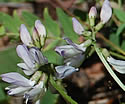Astragalus alpinus (Alpine Milkvetch)
| Also known as: | |
|---|---|
| Genus: | Astragalus |
| Family: | Fabaceae (Pea) |
| Life cycle: | perennial |
| Origin: | native |
| Status: |
|
| Habitat: | part shade, sun; gravelly or sandy cool lakeshores, ponds, creeks, meadows |
| Bloom season: | May - August |
| Plant height: | 8 to 12 inches |
| Wetland Indicator Status: | GP: FAC MW: none NCNE: FAC |
| MN county distribution (click map to enlarge): |  |
| National distribution (click map to enlarge): |  |
Pick an image for a larger view. See the glossary for icon descriptions.
Detailed Information
Flower: 

![[photo of flowers]](/udata/r9ndp23q/pd/astragalus-alpinus-7398-2-t.jpg) Pea-like flowers in a loose, spreading, cluster that elongates with maturity, growing on stalks emerging from stem tips and leaf axils, the flowering stem typically longer than the associated compound leaf. Flowers are about ½ inch long, the upper hood is light lavender with darker streaks into the throat, the lateral petals white, the deep keel longer than the petals, white at the base with a dark purple tip. The calyx holding the flower is green with sparse, flattened and darkened hairs, the lobes sharply triangular and hairy.
Pea-like flowers in a loose, spreading, cluster that elongates with maturity, growing on stalks emerging from stem tips and leaf axils, the flowering stem typically longer than the associated compound leaf. Flowers are about ½ inch long, the upper hood is light lavender with darker streaks into the throat, the lateral petals white, the deep keel longer than the petals, white at the base with a dark purple tip. The calyx holding the flower is green with sparse, flattened and darkened hairs, the lobes sharply triangular and hairy.
Leaves and stems: 

![[photo of leaves]](/udata/r9ndp23q/purple/alpine-milkvetch_0817_140922-t.jpg) The leaves are compound, up to 3 inches long with 15 to 25 small oval to egg-shaped leaflets, each ½ to ¾ inch long, that are somewhat hairy on the undersides and edges, the upper surface smooth or sparsely hairy. Stems grow laterally across the ground, up to 1½ feet long, erect at the tips, mostly smooth or with very fine sparse hairs, freely branching from an underground stem (caudex).
The leaves are compound, up to 3 inches long with 15 to 25 small oval to egg-shaped leaflets, each ½ to ¾ inch long, that are somewhat hairy on the undersides and edges, the upper surface smooth or sparsely hairy. Stems grow laterally across the ground, up to 1½ feet long, erect at the tips, mostly smooth or with very fine sparse hairs, freely branching from an underground stem (caudex).
Fruit: 
![[photo of fruit]](/udata/r9ndp23q/pd/astragalus-alpinus-7398-6-t.jpg) Fruits are small pods about ½ inch long, green and densely covered with silvery hairs. A deep grove runs the length of the pod's lower side.
Fruits are small pods about ½ inch long, green and densely covered with silvery hairs. A deep grove runs the length of the pod's lower side.
Notes:
Alpine Milk-vetch is widely distributed around the circumpolar regions of the world and as the name suggests, high alpine regions extending down throughout the Rockies. In Minnesota it is found exclusively in an small area of Lake county, growing around ground water fed ponds with complex hydrological patterns. Populations are subject to frequent flooding and may even depend upon it to thrive. The populations themselves move about these habitats and can be large and robust some seasons and scattered and diminished in others. In being what is considered a glacial relic restricted to a very small specific habitat, it is highly vulnerable to climate change and invasive species—Canada thistle and Reed Canarygrass are both creeping into the one known site in Minnesota. According to the DNR, it was listed as an endangered species in 1996. While many Astragalus species are similar, the habitat can distinguish Alpine Milkvetch from the rest, as well as the bi-colored flowers and densely hairy pods.
Native Plant Nurseries, Restoration and Landscaping Services ↓
More photos
Photos by K. Chayka and Peter M. Dziuk taken in Lake County.
Comments
Have you seen this plant in Minnesota, or have any other comments about it?
on: 2020-07-10 08:58:10
I believe there are several blooming plants in Creekside Park on the west end of the city. They appear about 20 feet from the walking path towards the river.
on: 2020-07-10 16:08:33
Josh, I suspect you saw a different species, since alpine milkvetch is only known from a single location in Lake County. If you'd like confirmation on your ID, post some photos on the Minnesota Wildflowers Facebook page.
on: 2020-07-12 21:59:27
Josh, what you saw was crown vetch, a terrible invasive species.







 Alpine Milkvetch plant
Alpine Milkvetch plant Alpine Milkvetch habitat
Alpine Milkvetch habitat